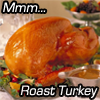Answer: brine! Brining is just an easy way to have perfectly cooked poultry every time. What is brining? It is much like marinating, in that you expose the meat to seasonings in order to tenderize the meat and make it become more flavorful. In this case, the seasoning is primarily salt, sometimes accompanied by sugar and/or herbs and flavorings. What does brining do? In a nutshell, it keeps the bird moist and tender through a process of osmosis. My inner chemistry nerd is trying to escape, so for those of you who want a scientific explanation, head to this link for the details. The rest of you, who probably could care less, can take my word that it is highly beneficial step in preparing poultry.
A brine can either be wet or dry but is traditionally wet. You simply submerge the meat in a plain saltwater bath or incorporate any other number of seasonings. I love the concise directions provided by America's Test Kitchen. It gives detailed information for roasting and grilling, along with substitutions for different types of salt. You can omit the sugar in any of the steps, and it will still be moist. The sugar doesn't impart a huge sweetness, but it can be off-putting in a especially savory recipe. While the general recommendation is 8 hours or more of brining, I have found that as little as one to two hours can make a big difference. If you only have a short amount of time, you can brine it on the counter-top instead of a cooler or refrigerator, which will allow the meat to return to room-temperature before cooking.
My new favorite option is dry-brining. Pam Anderson is probably my favorite cook out there. I am a little biased, as her mother is a dear friend of our family. I have never had the privilege to meet her but have enjoyed all her cookbooks, recipes, and especially inspiration during her dramatic weight-loss. Her blog, ThreeManyCooks, is terrific, too. But, I digress. My point being that she has a wonderful recipe for dry-brining a turkey with citrus. The original recipe that I use from the USA Today insert called for lemon instead of orange and 2 tablespoons each of fresh sage, rosemary, and thyme. I have baked it several times with amazing results. We are accustomed to frying turkeys here in Louisiana, but this is such a great recipe, without the inevitable fire hazard, that I don't fry anymore. If you butterfly the bird, you can cook it at 425 F for about 1 1/2 hours (internal temperature of 175 F in the thickest part of the thigh). I would have never believed you could cook a turkey in such a short amount of time with perfect results. This recipe is a great starting point to experiment with your own flavors and herbs. Of course, it works great with chicken as well. All you will need to do is decrease the cooking time (it will take approximately 45 minutes to 1 hour) and internal temperature to 165 F.
Now you never have to be shamed by a dry bird again!
Check out my Must Haves link at the top of the page for Pam's newest cookbook The Perfect Recipe for Losing Weight and Eating Great.


No comments:
Post a Comment